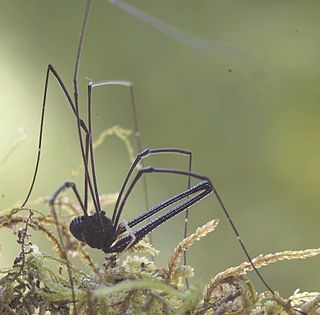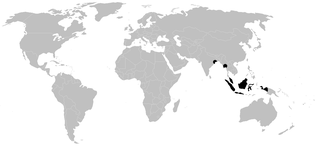Related Research Articles

Cosmetidae is a family of harvestmen in the suborder Laniatores. With over 700 species, it is one of the largest families in Opiliones. They are distributed from Argentina to the southern USA with the highest diversity in northern South America, Central America and Mexico. This Nearctic-Neotropical family comprises Opiliones with elaborate white/yellow/green/orange/red stripes and spots on the dorsal scutum and peculiar pedipalps strongly compressed and applied on the chelicerae.

The Eupnoi are a suborder of harvestmen, with more than 200 genera, and about 1,700 described species.
Megabunus is a genus of harvestmen with six known recent species. All occur in Europe, mostly in the vicinity of the Alps.

Megabunus diadema is a species of harvestman distributed in Western Europe, where it has been found in Iceland, Faroe Islands, Western Norway, Great Britain, Western France, Belgium and Northern Spain.

The Neopilionidae are a family of harvestmen.

The Stylocellidae are a family of harvestmen with about 30 described species, all of which occur from India to New Guinea. Members of this family are from one to seven millimeters long. While Stylocellus species have eyes, these are absent in the other two genera.
An ozophore is an elevated cone present in the harvestman suborder Cyphophthalmi. It carries the openings, called ozopores, of the defensive glands that are present in many harvestmen.

An ozopore is the opening of a defensive gland present in some arthropods, notably in millipedes of the order Polydesmida and in harvestmen, the eight-legged arachnids also known as "daddy long-legs". The glands themselves are known as ozadenes, also called "scent glands", "repugnatorial glands", "odoriferous glands" or "stink glands" by various authors. The name is derived from Ancient Greek ozo "smell" and Latin porus "pore, small opening".
Nemastomoides is an extinct genus of harvestmen known from the Carboniferous fossil record. The genus is the only member of the family Nemastomoididae and contains three described species. Nemastomoides elaveris was found in the Coal Measures of Commentry in northern France, together with Eotrogulus fayoli.

The Ceratolasmatidae are a family of harvestmen with eleven described species.
Assamiidae are a family of harvestmen with more than 400 described species. It is the third most diverse family of the suborder Laniatores.
The Stygnidae are a family of neotropical harvestmen within the suborder Laniatores.

The Cranaidae are a family of neotropical harvestmen within the suborder Laniatores.
The Icaleptidae are a small family of neotropical harvestmen within the suborder Laniatores. Although only two species have been described, many more are probably to be discovered.
Escadabiidae is a small neotropical family of the harvestman infraorder Grassatores with six described species.
The Fissiphalliidae are a small neotropical family of harvestmen within the suborder Laniatores.
The Synthetonychiidae are a small family of harvestman with a handful of species in a single genus. They are endemic to New Zealand.
The Travuniidae are a small family of harvestman with little more than ten described species, within the suborder Laniatores.
Stomotheca is the term applied to the feeding apparatus in front of the mouth of harvestmen, and sometimes the related scorpions. Usually it consists of the epistome (labrum), two pairs of coxapophyses and often a labium.
Abaetetuba is a genus of harvestmen in the family Sclerosomatidae.
References
- Joel Hallan's Biology Catalog: Eotrogulidae
- Thevenin, A. (1901): Sur la découverte d'arachnides dans le terrain houiller de Commentry. Bull Soc Géol. Fr.4(1): 605-611.
- Petrunkevitch, A. I. (1955): Arachnida. pp. 42–162 in Treatise on Invertebrate Palaeontology , part P. Arthropoda 2 (R. C. Moore, ed.). Geological Society of America & University of Kansas Press, Lawrence.
- Pinto-da-Rocha, R., Machado, G. & Giribet, G. (eds.) (2007): Harvestmen - The Biology of Opiliones. Harvard University Press ISBN 0-674-02343-9